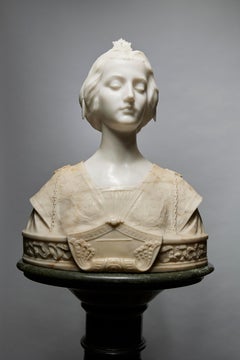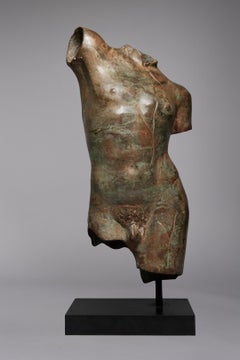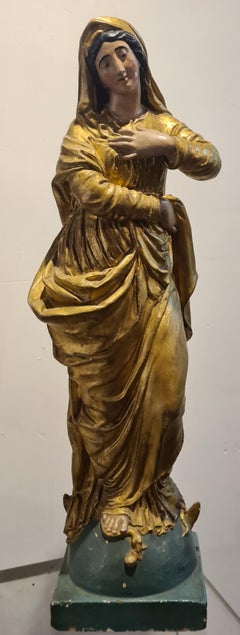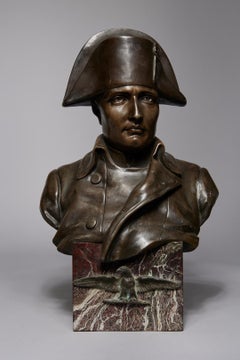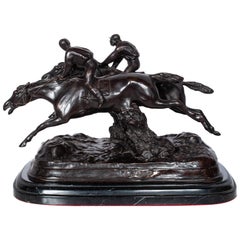Late 19th Century Figurative Sculptures
to
25
95
48
71
32
19
Overall Width
to
Overall Height
to
187
564
2,169
7,593
68
53
93
118
60
122
200
171
218
278
62
3
2
2
1
1
219
174
167
140
123
73
46
29
25
21
18
12
9
8
7
6
5
5
4
4
215
210
44
38
12
21
7
7
5
5
159
106
Period: Late 19th Century
Late 19th Century Italian Finely Finished Bust of Renaissance Lady w/ Pedestal
Located in Beachwood, OH
Italian, Late 19th Century
Finely Finished Bust of Renaissance Lady
White marble, garment in veined buff colored marble on fitted green marble pedestal
Bust: 22 x 18 x 9 inches
Pedes...
Category
Late 19th Century Figurative Sculptures
Materials
Marble
Patinated Bronze Torso after the Antique, 19th/20th Century
Located in Beachwood, OH
Patinated Bronze Torso after the Antique, 19th/20th Century
Bronze
Torso: 22 x 13 x 11 inches
Including base: 27 inches high
Category
Late 19th Century Figurative Sculptures
Materials
Bronze
French Polychrome and Gilded Statue of The Virgin Mary
Located in Cotignac, FR
A polychrome and gilt plaster statue of the Blessed Virgin Mary. The quality of the original gilding and the handling of the folds in the clothing are exceptional.
A wonderful statu...
Category
Renaissance Late 19th Century Figurative Sculptures
Materials
Gold Leaf
Late 19th Century Bronze Bust of Napoleon Sculpture, Italian Artist
Located in Beachwood, OH
Raphaël Nannini (Italian, 1852-1925)
Napoleon Bust, Late 19th Century
Bronze on marble base
Signed on back
17 x 11 x 8 inches
Raphael Nannini was born in Florence. He exhibited at t...
Category
Late 19th Century Figurative Sculptures
Materials
Marble, Bronze
VALTON Charles. The Griffin Marco. Patinated bronze. Marble base. Signed.
Located in Paris, FR
The Griffin Marco. Patinated bronze. Marble base. Signed and titled.
Charles Valton was a French sculptor known for his works created in the animalier style, a 19th-century movement ...
Category
Realist Late 19th Century Figurative Sculptures
Materials
Bronze
Antique French 19th Bronze Equestrian Group Horses Jockeys Statue Sculpture 1895
Located in Portland, OR
A fine late 19th century antique French bronze sculpture group, of a pair of race horses & jockeys, by Paul Louis Emile Loiseau-Rousseau, Paris (1861-1927).
The bronze circa 1895 de...
Category
French School Late 19th Century Figurative Sculptures
Materials
Bronze
Il Bernini - Sculpture by Ambrogio Borghi - 1884
Located in Roma, IT
The bronze proposed here was initially presented in November 1878 at the Competition for the Encouragement of Brera. It is therefore one of the first celebratory works of the sculptor Ambrogio Borghi...
Category
Modern Late 19th Century Figurative Sculptures
Materials
Bronze
The Blacksmith of Solingen / - The Double-edged Sword -
Located in Berlin, DE
Wilhelm Albermann (1835 Werden an der Ruhr - 1913 Cologne), The Blacksmith of Solingen, after 1895. Bronze-color patinated zinc cast on plinth, 47 cm (height) x 20 cm (width) x 16 cm (depth), weight 5.5 kg. Signed “Albermann.” on the plinth and identified as a cast by “AKT.[TIEN] GES.[ELLSCHAFT] GLADENBECK BERLIN”. Dedication on the front: “Mr. Ing. F. Kuhlmann to the wedding. Management and officials of the Hannoversche Waggonfabrik. Aircraft construction department".
- The zinc showing through in spots, the patina somewhat stained, the right upper arm under the sleeve retouched in black.
- The Double-edged Sword -
The figure is a reduction of Wilhelm Albermann's 1895 fountain figure of the armourer of Solingen, who has always been identified with the historical blacksmith Peter Hahn. In 1839, Karl Simrock wrote the poem “The Blacksmith of Solingen" and thus coined the legendary figure. The first and penultimate verses read:
A blacksmith spoke to Solingen
With every bayonet,
That came to his diligence:
"Oh, that Fritz had it!"
The war took its course,
Many battles were fought,
Which often made him fearful and anxious
In his soul.
The blacksmith had given up his trade to fight for Frederick the Great. Not least because of his strength and will to fight, the battles were won. With his fountain sculpture, Albermann has given the legendary blacksmith a figurative form and at the same time created a landmark for the city of Solingen, which was once famous for the art of sword forging and today still stands for the production of high-quality knives. During the bombing raid in November 1944, the fountain was destroyed along with the entire old town of Solingen. Only the head remained.
The broad-shouldered blacksmith stands securely behind his anvil, his leather apron tied around him, and has just finished a sword blade with his own "weapon" - the blacksmith's hammer. His entire body shows the strength with which he wields the hammer, but also the strain of this activity, as evidenced by the wide open shirt, the somewhat 'untidy' apron, and especially the furrowed face.
However, the blacksmith does not look at the finished work, but resolutely and at the same time thoughtfully into the distance, in line with the quoted verse from Simrock's poem that the battles "often made him fearful and anxious in his soul". There is certainly something melancholy in his gaze, fed by the knowledge of the necessity of forging swords and taking up arms and their deadly use - experiences Albermann had to make during his own war missions. The flowing full beard gives his gaze into the distance an almost prophetic character.
In keeping with the craft of the perfectly formed art of blacksmithing, the detailed casting reproduces the respective materials depicted in perfect form: the leather apron convincingly conveys the impression of leather and lies - also in the back view - like a second formed layer over the body, while the shirt and trousers illustrate their own textile qualities.
Due to its masterful execution and profound content, the “Blacksmith of Solingen”, which has survived in its cast reproductions, remains Albermann's most famous work to this day.
About the artist
The son of a carpenter, Wilhelm Albermann began an apprenticeship as a joiner, but then followed his artistic calling and trained as a sculptor in Elberfeld. In 1855, at the age of twenty, he was drafted into the army in Berlin, where he served until 1857. Albermann attended the Berlin Art Academy on the side and began regular studies after his service. While still a student, he completed commissioned works for his teachers August Fischer and Hugo Hagen. His first independent commissions followed, enabling him to establish a flourishing sculpture studio in Cologne in 1865. His artistic activities were repeatedly interrupted by military service, and he took part in the German-Danish War in 1864, the war against Austria in 1866, and the Franco-Prussian War in 1870/71. After his last war service, Albermann, already a respected artist, founded a commercial drawing school at the request of the city government, where he taught the modeling class and served as director until 1896. In 1890 he also worked for the "Society for the Promotion of Sculpture in the Rhineland and Westphalia".
Albermann was one of the most prolific sculptors in Cologne in the second half of the 19th century. He created numerous monuments, fountains, tomb sculptures, architectural ornaments, and domestic statues. At its peak, his workshop employed up to thirty sculptors and stonemasons at a time.
GERMAN VERSION
Wilhelm Albermann (1835 Werden an der Ruhr - 1913 Köln), Der Schmied von Solingen, nach 1895. Bronzefarben patinierter Zinkguss auf gegossener Plinthe, 47 cm (Höhe) x 20 cm (Breite) x 16 cm (Tiefe), Gewicht 5,5 kg. Auf der Plinthe mit „Albermann.“ signiert und als Guss der „AKT.[TIEN] GES.[ELLSCHAFT] GLADENBECK BERLIN“ ausgewiesen. Schauseitige Widmung: „Herrn Ing. F. Kuhlmann zur Vermählung. Direktion und Beamte der Hannoverschen Waggonfabrik. Abt. Flugzeugbau“.
- Punktuelles Durchscheinen des Zinks, Patina etwas fleckig, der rechte Oberarm unter dem Ärmel schwarz retuschiert.
- Die Zweischneidigkeit des Schwertes -
Die Figur ist eine Reduktion von Wilhelm Albermanns 1895 geschaffener Brunnenfigur des Waffenschmieds von Solingen, der seit jeher mit dem historischen Schmied Peter Hahn identifiziert wurde. 1839 hatte Karl Simrock das Gedicht „Der Schmied von Solingen“ verfasst und damit die legendäre Figur geprägt. Die erste und die vorletzte Strophe lauten:
Zu Solingen sprach ein Schmied
Bei jedem Bajonette,
Das seinem Fleiß geriet:
»Ach, daß der Fritz es hätte!«
Der Krieg ging seinen Gang,
Man schlug noch viele Schlachten,
Die oft ihm angst und bang'
In seiner Seele machten.
Der Schmied hatte sein Handwerk ruhen lassen, um selbst für Friedrich den Großen zu kämpfen. Nicht zuletzt durch seine Kraft und seinen Kampfeswillen verliefen die Schlachten siegreich. Dem legendären Schmied verlieht Albermann mit seiner Brunnenskulptur eine bildliche Gestalt und schuf damit zugleich ein Wahrzeichen der Stadt Solingen, die einst für die Kunst des Schwerterschmiedens berühmt war und bis heute für die Herstellung qualitätvoller Messer einsteht. Beim Bombenangriff im November 1944 wurde mit der gesamten Solinger Altstadt auch der Brunnen zerstört. Einzig der Kopf blieb erhalten.
Mit sicherem Stand und umgebundener Lederschürze steht der breitschultrige Schmied hinter seinem Amboss und hat gerade mit seiner eigenen ‚Waffe‘ – dem Schmiedehammer – eine Schwertklinge fertiggestellt. Seinem gesamten Körper ist die Kraft abzulesen, mit der er den Hammer führt, aber auch die Anstrengung dieser Tätigkeit, wovon das weit geöffnete Hemd, die etwas ‚unordentlich‘ arrangierte Schürze und vor allem das zerfurchte Gesicht zeugen.
Der Schmied schaut aber nicht auf das vollendete Werk, sondern entschlossen und zugleich sinnierend in die Ferne, entsprechend der zitierten Zeile von Simrocks Gedicht, dass die Schlachten „oft ihm angst und bang‘ in seiner Seele machten“. Der Blick hat durchaus etwas Melancholisches, dass sich aus dem Wissen um die Notwendigkeit, Schwerter zu schmieden und zu den Waffen zu greifen und deren tödlichem Einsatz speist – Erfahrungen, die Albermann bei seinen eigenen Kriegseinsätze machen musste. Der wallende Vollbart verleiht dem in die Ferne schauenden Blick einen beinahe prophetischen Charakter.
Dem Handwerk der formvollendenden Schmiedekunst entsprechend, gibt der detaillierte Guss die jeweils dargestellten Materialien in vollendeter Ausformung wieder: Die Lederschürze vermittelt überzeugend den Eindruck des Leders und liegt – auch in der Rückenansicht – wie eine zweite ausgeformte Schicht über dem Körper, während das Hemd und die Hose...
Category
Realist Late 19th Century Figurative Sculptures
Materials
Metal
$1,339 Sale Price
20% Off
Diana the Huntress, 1890 Classical Bronze Sculpture of Nude Woman
Located in Beachwood, OH
Frederick William MacMonnies (American, 1863-1937)
Diana, 1890
Bronze with green verdigris patina
Signed and dated
Copyright 1894 with Jaboeuf & Rouard, Paris foundry mark
31 x 21 x 17 inches
A sculptor of classical figures, American-born Frederick MacMonnies...
Category
Late 19th Century Figurative Sculptures
Materials
Bronze
horse. 19th century bronze sculpture
Located in CORAL GABLES - MIAMI, FL
horse. 19th century bronze sculpture
measurements with the base are 37.5 x 17.5 x 31 cm
Category
Art Nouveau Late 19th Century Figurative Sculptures
Materials
Bronze
David Slaying Goliath Large Figural Bronze Statue by Antonin Mercie
Located in New York, NY
The base marked "A. Mercie" and "506 F. Barbenienne, Fondeur, Paris" ad "A. Collas" "Reduction Mecanique."
The dazzling David, a prolific subject amongst sculpture artists beginning...
Category
Academic Late 19th Century Figurative Sculptures
Materials
Bronze
Equestrian Joan of Arc
Located in PARIS, FR
Equestrian Joan of Arc
by Emmanuel FREMIET (1824-1910)
A very fine bronze equestrian group with a greenish dark brown patina
signed " Fremiet " on the base
cast by " F. Barbedienne...
Category
French School Late 19th Century Figurative Sculptures
Materials
Bronze
19th Century Old Man & Woman Bronze Sculptures
Located in San Francisco, CA
19th Century Old Man & Woman Bronze Sculptures
These charming bronze sculptures have a rich patina that only comes with age
Each bronze measures 2" square at the base x 5" high
No...
Category
Late 19th Century Figurative Sculptures
Materials
Bronze
Antique French Egyptian Revival Bronze Bust Sculpture Statue "Queen of Babylon"
Located in Portland, OR
A good antique cast bronze sculpture an Egyptian Revival bust "The Queen of Babylon", by the 19th century French sculptor Paul Auguste Gagne, circa 1875.
This rare & unusual bronze b...
Category
French School Late 19th Century Figurative Sculptures
Materials
Bronze
Inspiration
Located in Los Angeles, CA
Beautiful Art Nouveau marble.
Campagne, Pierre Étienne Daniel French , 19th century , male. Active in Paris. Born 1851 , in Gontaud (Lot-et-Garonne). S...
Category
Art Nouveau Late 19th Century Figurative Sculptures
Materials
Marble
Equestrian Louis of Orleans
Located in PARIS, FR
Equestrian Louis of Orleans
by Emmanuel FREMIET (1824-1910)
A very fine bronze equestrian group with a gilded patina
Signed " E. Fremiet " on the base
Cast by " F. Barbedienne Fond...
Category
French School Late 19th Century Figurative Sculptures
Materials
Bronze
Large Alabaster Sculpture Satyr with Cymbals Volterran workshop 19th century
Located in Pistoia, IT
Large alabaster sculpture depicting the Satyr with cymbals, 19th-century Volterra workshop.
The satyr with cymbals is a Roman marble sculpture preserved in the Uffizi Museum in F...
Category
Italian School Late 19th Century Figurative Sculptures
Materials
Alabaster
19th century French Bronze of a naked woman standing up.
Located in Woodbury, CT
Well modeled 19th century French bronze of a standing naked woman.
Signed Cartinet, this piece is a wonderful example of the skill of a Sculptor.
The piece retains all its origina...
Category
Victorian Late 19th Century Figurative Sculptures
Materials
Bronze
$1,356 Sale Price
20% Off
Italian 19th Century Carrara Marble Sculpture " Young Beauty Going for a Swim"
Located in LA, CA
A very fine Italian 19th century Carrara marble sculpture depicting a young beauty going for a Swim standing on the steps of a dock, raised on its original carved green marble pedest...
Category
Academic Late 19th Century Figurative Sculptures
Materials
Marble
Antique Bronze Portrait Draft Horse by Isidore Jules Bonheur (France, 1827-1901)
Located in SANTA FE, NM
Antique Bronze Portrait of a Draft Horse
Isidore Jules Bonheur (France, 1827-1901)
Circa 1840s
Cast bronze mounted on a rectangular plinth atop a marble s...
Category
Realist Late 19th Century Figurative Sculptures
Materials
Bronze
A la fontaine
By Émile Nestor Joseph Carlier 1
Located in Mc Lean, VA
Nice 19th-century cast with rich, brown patina by French sculptor Emile-Joseph-Nestor Carlier. Carlier frequently created large, multi-figural group sculptures. These are dramatic an...
Category
Realist Late 19th Century Figurative Sculptures
Materials
Bronze
$11,500
Lifesize Italian 19th Century Orientalist Marble Sculpture of Assyrian Princess
Located in LA, CA
Eliseo Tuderte Fattorini (Italian, 1830-1887). A very fine and life-size Italian, 19th century marble Life-size Orientalist Marble Sculpture of an Assyrian Princess (Previously descr...
Category
Academic Late 19th Century Figurative Sculptures
Materials
Marble
Family Of Lions Bronze By Paul Édouard Delabrierre
Located in Norwood, NJ
A family of lions having green patination depicting a male lion feeding two cubs; mounted on a naturalistic base - signed and applied entitled plaque "Lion 1st Gibier"
Paul Edouard Delabrierre...
Category
Late 19th Century Figurative Sculptures
Materials
Bronze
“Diana”
Located in Southampton, NY
Beautiful golden brown patina bronze of Diana, the goddess of the moon by the French sculptor, Emmanuel Villanis. Signed on her shoulder. Impressed foundry stamp on base, “Society de...
Category
Academic Late 19th Century Figurative Sculptures
Materials
Bronze
$2,600 Sale Price
25% Off
Cubist Couple
Located in Los Angeles, CA
CHARNA RICKEY
"THE COUPLE"
BRONZE, SIGNED
AMERICAN, DATED 1976,
14.5 INCHES OVERALL
Recent casting
Category
Cubist Late 19th Century Figurative Sculptures
Materials
Bronze
Emile Boisseau "Le Troubadour" Patinated Bronze
Located in Astoria, NY
After Emile Andre Boisseau (French, 1842-1923) "Oysel - Le Troubadour" Patinated Bronze Sculpture, late 19th century, depicting a seated minstrel, on a circular base with applied pla...
Category
Late 19th Century Figurative Sculptures
Materials
Bronze
French 19th century Animalier bronze of Two Hares on a naturalistic base
Located in Bath, Somerset
19th century bronze group of a standing and sitting hare by French animalier sculptor Alfred Dubucand (1823-1894). Finely detailed bronze with good dark brown patination. Signature '...
Category
Naturalistic Late 19th Century Figurative Sculptures
Materials
Bronze
The Victorious David / - The melancholy of the radiant hero -
Located in Berlin, DE
Henri Honoré Plé (1853 Paris - 1922 Paris), The Victorious David, around1890. Red-brown and brown patinated bronze with terrain plinth mounted on a round base. 42 cm (total height) x...
Category
Realist Late 19th Century Figurative Sculptures
Materials
Bronze
$1,817 Sale Price
20% Off
"The Farewell Kiss"
Located in Southampton, NY
This is a beautiful original bronze casting by the foremost Russian sculptor of his day Evgeny Lanceray. Artist signed on the base in Cyrillic (image 5) and is also inscribed on the ...
Category
Realist Late 19th Century Figurative Sculptures
Materials
Bronze
$12,500 Sale Price
24% Off
Tiger and Lion walking
Located in PARIS, FR
Rare pair of "Tiger and Lion walking"
by Antoine-Louis BARYE (1796-1875)
A very fine pair of bronze sculptures with a nuanced brown patina
each signed "Barye" on the base
cast by "F...
Category
French School Late 19th Century Figurative Sculptures
Materials
Bronze
Apple Dancer
Located in PARIS, FR
Apple Dancer
by Jean-Léon GEROME (1824-1904)
Bronze sculpture with a dual patina, brown and gilded
signed on the base "JL. GEROME"
cast by "Siot-Decauville Fondeur Paris" (foundry s...
Category
Art Nouveau Late 19th Century Figurative Sculptures
Materials
Bronze
Rare, Antique, Life-Size Dog Bronze of a Chihuahua "Lydie" Charles Valton. 1890s
Located in SANTA FE, NM
Antique Bronze Dog Sculpture
Chihuahua "La Petite Belle Lydie"
Charles Valton (French, 1851-1918)
Circa 15 1/2 x 10 1/4 x 7
Lydie is a Chihuahua making her a very rare image from ...
Category
Realist Late 19th Century Figurative Sculptures
Materials
Bronze
Mountain Goat
Located in Missouri, MO
Jules Moigniez
"Mountain Goat"
Bronze
approx 11 x 9 x 4 inches
Signed
Jules Moigniez (1835-1894)
Jules Moigniez was born in Senlis sur L'Oise, France ...
Category
Realist Late 19th Century Figurative Sculptures
Materials
Bronze
Horse training with its stable lad
Located in PARIS, FR
Horse training with its stable lad
by Arthur Marie Gabriel comte du Passage (1838-1909)
A bronze group with nuanced dark brown patina
Signed on the base " Cte du Passage "
Period ca...
Category
French School Late 19th Century Figurative Sculptures
Materials
Bronze
Edgard Degas: Horse Clearing an Obstacle (work 48 /certified by Comité Degas)
By Edgar Degas
Located in Gent, VOV
Horse Clearing an Obstacle (work number 48)
Bronze with dark brown green patina bearing the stamp of the signature "Degas",
Numbered IV/IX and dated 1998
Posthumous lost wax casting as of 1998.
Stamp of Valsuani.
Signed Degas
The work is a sought-after rarity in terms of Degas’ sculptures. This bronze is distinguished by the fact that it is a Valsuani bronze, meaning it faithfully records Degas’ wax version’s as it appeared at the time of its creation. Most Degas' bronzes that are found on the market were cast by Hébrard – these serialized bronzes are surmoulages, or “aftercasts,” that were cast from the modèle bronzes currently in the Norton Simon Museum (Pasadena). Because these Hebrard bronzes...
Category
Impressionist Late 19th Century Figurative Sculptures
Materials
Bronze
“Enlevement des Sabines”
Located in Southampton, NY
Here for your consideration is a beautiful highly detailed bronze done in the forth quarter of the nineteen century after the work of Jean Boulogne, known as Giambologna. Boulogne’s sculpture was done in marble and was completed between 1579 and 1583. The sculptor of this bronze is Antonin Mercie, a well known French sculptor born in 1845. The bronze represents the Rape of the Sabine Women (Latin: Sabinae raptae), also known as the Abduction of the Sabine Women or the Kidnapping of the Sabine Women, was an incident in Roman mythology in which the men of Rome committed a mass abduction of young women from the other cities in the region. It has been a frequent subject of artists and sculptors, particularly during the Renaissance and post-Renaissance eras. Signed on base “Mercie” for Antonin Mercie.. In very good condition wirh original brown patina. The base which depicts rocks is bronze and has been painted a matt black. Provenance:: A Sarasota estate.
Mercié, (Marius Jean Antonin Mercie...
Category
Academic Late 19th Century Figurative Sculptures
Materials
Bronze
$3,040 Sale Price
20% Off
Late 19th Century Chinese Decorated Metal Covered Ginger Jar in Japanese Style
Located in Beachwood, OH
Late 19th Century Chinese
Decorated Metal Covered Ginger Jar in the Japanese Style
Labeled on bottom Ralph M. Chait Galleries, New York
9 x 7.5 x 7.5 inches
Ginger jars were used...
Category
Late 19th Century Figurative Sculptures
Materials
Metal
Monumental Pair French 19th Century Putto Flambeaux Urns Torchere Urn Sculptures
Located in LA, CA
A Monumental Museum Quality Pair of French 19th Century Figural Gilt and Patinated Bronze Rosso Granite Marble Flambeaux Urns, each depicting a pair of standing allegorical and whims...
Category
Romantic Late 19th Century Figurative Sculptures
Materials
Granite, Marble, Brass, Bronze
Large French Art Nouveau Patinated Terracotta Sculpture Signed
Located in Pistoia, IT
Luca Madrassi (1848-1919), large patinated terracotta sculpture in Art Nouveau style, late 19th century. The sculpture depicts a half-naked young woman sitting in a tree holding a m...
Category
Art Nouveau Late 19th Century Figurative Sculptures
Materials
Terracotta
Head of Lust (Tete de la Luxure)
Located in New York, NY
Originally conceived in 1880-82 for the tympanum of the Gates of Hell, where she is cradled in the arms of L'homme qui tombe, as well as crouching in slightly varied form to the lef...
Category
Impressionist Late 19th Century Figurative Sculptures
Materials
Bronze
Horse training with its stable lad
Located in PARIS, FR
(after) Arthur Marie Gabriel comte du Passage (1838-1909)
Horse training with its stable lad
A rare large bronze group with nuanced dark brown patina
circa 1896
signed on the base "...
Category
French School Late 19th Century Figurative Sculptures
Materials
Bronze
Late 19th century Grand Tour bronze of the Dancing Faun
Located in Bath, Somerset
A 19th century 'Grand Tour' bronze figure of the Dancing Faun, standing on a bronze square plinth. The faun balances on his toes and pivots, his horned head raised, his hair wreathe...
Category
Late 19th Century Figurative Sculptures
Materials
Bronze
Alerte
Located in New York, NY
AUGUSTE MOREAU
French, (1834-1917)
Alerte
Patinated bronze; Signed ‘Aug Moreau’ and title ‘Alerte’ on base
22 x 14 1/2 inches
Notes:
Cupid's figure is standing with a bow on hi...
Category
Late 19th Century Figurative Sculptures
Materials
Bronze
Bust of a young woman / - The Opulence of Beauty -
Located in Berlin, DE
Anton Nelson (i.e. Antoine Joseph van den Kerckhoven) (1849 Brussels - after 1910 ibid.), Bust of a young woman, c. 1890. Patinated bronze on cast base, 30 cm (total height) x 20 cm ...
Category
Art Nouveau Late 19th Century Figurative Sculptures
Materials
Bronze
The Birth of Venus
By Albert-Ernest Carrier-Belleuse 1
Located in PARIS, FR
The Birth of Venus
by Albert-Ernest CARRIER-BELLEUSE (1824-1887)
Bronze sculpture with nuanced dark brown patina
signed "A. Carrier-Belleuse"
cast by Denière
France
circa 1870
he...
Category
French School Late 19th Century Figurative Sculptures
Materials
Bronze
Antoine Louis Barye Bronze Dromadaire Harnaché D'Égypte Camel
Located in Dallas, TX
ANTOINE-LOUIS BARYE (FRENCH, 1796-1875): A patinated bronze model of Dromadaire harnaché d'Égypte
Signed 'BARYE' and stamped 'BARYE' by the Brame foundry
Raised on naturalistic base...
Category
Late 19th Century Figurative Sculptures
Materials
Bronze
Bronze Reliefs of Minerva and Mars by Émile Pinedo
By Émile Pinedo
Located in New Orleans, LA
Émile Pinedo
1840-1916 French
Bronze Reliefs of Minerva and Mars
Bronze
These exceptional bronze reliefs depicting the Roman deities Minerva and Mars represent the pinnacle of 19...
Category
Late 19th Century Figurative Sculptures
Materials
Bronze
Tiger surprising an antelope
Located in PARIS, FR
Antoine-Louis BARYE (1796-1875)
Tiger surprising an antelope
Bronze with nuanced dark greenish brown patina
Signed on the base " Barye "
Cast by Barye's own workshop (conducted in t...
Category
French School Late 19th Century Figurative Sculptures
Materials
Bronze
Standing Bull, head bowed
Located in PARIS, FR
Standing Bull, head bowed
by Isidore BONHEUR (1827-1901)
A bronze sculpture with a nuanced dark brown patina
Signed on the base " I. Bonheur "
A period cast by " Peyrol " (with the...
Category
French School Late 19th Century Figurative Sculptures
Materials
Bronze
A 19th century French animalier bronze of a greyhound
By Joseph Francois Victor Chemin
Located in Bath, Somerset
A late 19th century bronze figure of a greyhound, his front leg raised and head turned backwards as he grooms his coat. A finely detailed figure with a dark brown patina, mounted on ...
Category
French School Late 19th Century Figurative Sculptures
Materials
Bronze
Antique French Polish Gilt Bronze Statue Sculpture Figure Sword Bladesmith 1890
Located in Portland, OR
A fine antique French gilt bronze sculpture of a swordsmith, by the French- Polish artist & sculptor Henryk II Kossowski (1855-1921), the bronze dating to 1890.
The bronze depicts a ...
Category
French School Late 19th Century Figurative Sculptures
Materials
Alabaster, Bronze
The Secret
Located in PARIS, FR
The Secret
by Pierre-Félix FIX-MASSEAU (1869-1937)
Sculpture in bronze with a gilded patina
Signed on the side " Fix-Masseau "
Cast by " Siot-Paris " (with the foundry mark)
France...
Category
Art Nouveau Late 19th Century Figurative Sculptures
Materials
Bronze
Figural Group of Venus Flanked by Putti
Located in New York, NY
LOUIS AUGUSTE MOREAU
French, (1834-1917)
Figural Group of Venus Flanked by Putti
Patinated bronze; Signed ‘Ate Moreau’
28 in. x 11 in x 8 inches
Notes:
Having a deep brown...
Category
Late 19th Century Figurative Sculptures
Materials
Bronze
Large Neapolitan 19th Century Hardwood Sculpture of a Crèche Camel.
Located in Cotignac, FR
Large, Neapolitan, late 19th Century hardwood sculpture of a camel. Artist unknown.
A beautifully patinated hardwood sculpture. The sculpture is extremely charming and having been handled for over a century has a lovely warm and tactile patina. It is particularly nice too see the work of the craftsperson in the adze and chisel marks along the body of the sculpture. The Italians and most notably the area around Naples has a long and storied tradition in the creation of sculptures for Nativity Scenes. This camel is both an endearing item and a piece of social history.
A wonderful addition in its own right to the traditional Christmas scene, by tradition this sculpture was used as a maquette for the production of papier-maché models used in Christmas Creches which have such a long tradition in Italy and throughout the world. Wonderfully carved this piece was used to create hollow models out of papier-maché which were more affordable for this Christmas tradition. Hundreds of strips of papier-maché would be layered onto the figure in all directions. Then using a sharp tool the papier-maché was pushed into all the crevices of the sculpture to give it crisp detail. Once the layers of paper were dry the papier-maché was cut at certain points and lifted off the sculpture. Then finally the resulting body parts were glued back together, painted and patinated ready to be placed in the crèche scene.
In the Christian tradition, a nativity scene (also known as a manger scene...
Category
Art Nouveau Late 19th Century Figurative Sculptures
Materials
Wood
$1,721 Sale Price
40% Off
Tartar warrior stopping his horse
Located in PARIS, FR
Tartar warrior stopping his horse
by Antoine-louis BARYE (1796-1875)
Equestrian group in bronze with a nuanced dark greenish brown patina
any cast mark
old edition cast
France
cir...
Category
French School Late 19th Century Figurative Sculptures
Materials
Bronze
Bust in patinated plaster " terracotta style " 19th century with Louvre seal
Located in Gavere, BE
Important patinated plaster bust representing the Faun of Vienna.
the original of which is in the collections of the Louvre museum (marble statue discovered in Vienna in 1820 and dat...
Category
Baroque Late 19th Century Figurative Sculptures
Materials
Plaster
Reading Woman / - The golden glow of imagination -
Located in Berlin, DE
Albert-Ernest Carrier-Belleuse (1824 Anizy-le-Château - 1887 Sèvres), Reading Woman, around 1880. Polished bronze mounted on a cast base. 33 cm (total height) x 9 cm (length) x 9 cm ...
Category
Realist Late 19th Century Figurative Sculptures
Materials
Bronze
$2,295 Sale Price
20% Off
Marie de' Medici
Located in Douglas, Isle of Man
Mathurin Moreau 1822-1912, was a French sculptor in the classic academic style. His father was also a sculptor and his siblings. Mathurin first received a medal at the Salon in 1848,...
Category
Late 19th Century Figurative Sculptures
Materials
Bronze
Jockey Winner
Located in PARIS, FR
Jockey Winner
by Isidore BONHEUR (1827-1901)
A rare and magnificent bronze group with a dark brown patina
Signed on the base "I. Bonheur"
A period cast by "Peyrol" (with the foundry stamp)
Standing on a molded wooden base
France
circa 1880
height of the bronze : 53,5 cm
total height with the base : 62 cm
total length : 68 cm
depth : 24 cm
Biography:
Isidore Jules Bonheur (1827-1901) was a French painter and sculptor. Isidore first received an artistic apprenticeship from his father Raymond and his older sister Rosa, then, in 1827, he entered the School of Fine Arts in Paris. After practicing...
Category
French School Late 19th Century Figurative Sculptures
Materials
Bronze
Bear standing
Located in PARIS, FR
Bear standing
by Antoine-Louis Barye (1796-1875)
Rare bronze sculpture with a nuanced dark brown patina
Probably cast by Brame (old edition)
France
circa 1880-1890
height 24 cm
A ...
Category
French School Late 19th Century Figurative Sculptures
Materials
Bronze
